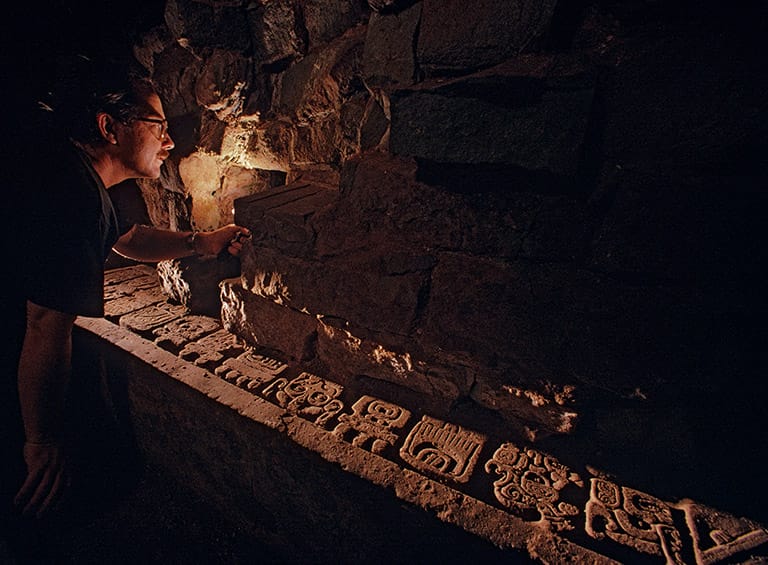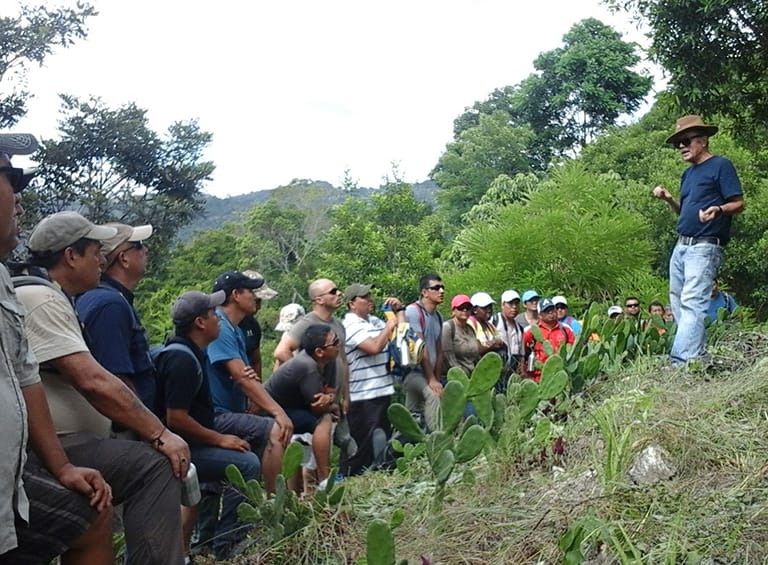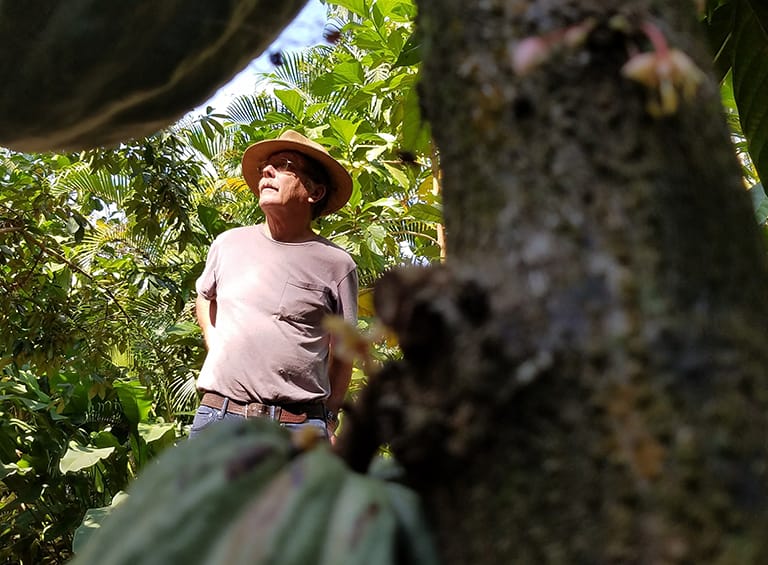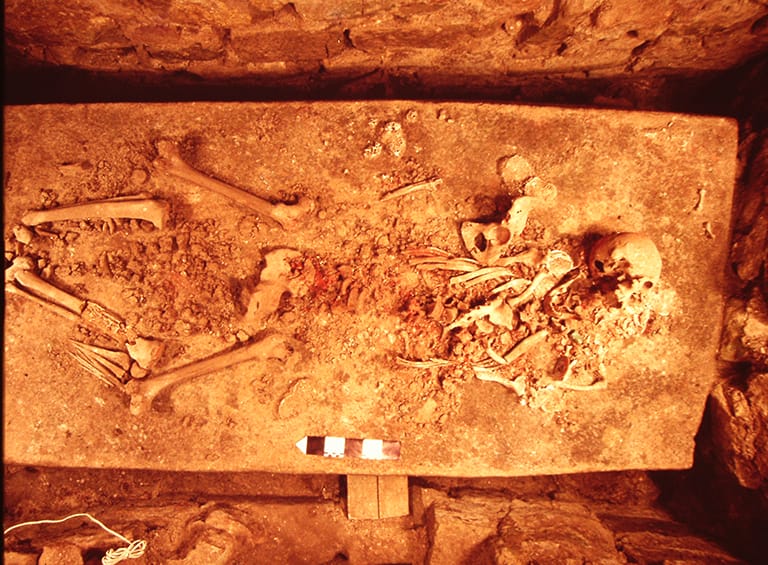Copán & Chocolate: After Uncovering the Maya World, David Sedat Now Works to Preserve its Cacao Legacy

by Margaret Shakespeare
Archaeologist David Sedat (MA, Anthropology, ’72), an admired authority on Maya history and culture, reckons his professional life in archaeological terms. “I like to think I have been an archaeologist about one-half of one-tenth of a millennium,” he says with a customary dry wit. That’s going on 50 years, to help with the arithmetic. Aside from a short stint in the early 1970s as assistant curator at Pomona College’s now-defunct Claremont Colleges Museum—under the direction of his mentor and then-Pitzer College Professor Robert Sharer—Sedat has spent nearly all of that time in Guatemala and Honduras. He followed Sharer to the University of Pennsylvania Museum of Archaeology and Anthropology, where as a research specialist Sedat led investigations that discovered the lavish jade-laden tombs of Yax K’uk Mo’ (Green Quetzal Macaw)—Copán’s Classic Maya Period (426-820 AD) royal dynastic founder Yax K’uk Mo’—and his presumed wife (known as The Lady in Red; her bones were painted with red cinnabar). Even though he officially retired from the museum in 2012, Sedat now makes Copán Ruinas, Honduras, his home and is still actively creating a legacy.
Spending his childhood in Guatemala, where his parents served as missionaries and Bible-translators, a 10-year-old Sedat made a flash decision that archaeology would be his career path. He remembers the surprise of walking along a railroad track near the border with Honduras to come upon a stela, rising 26 feet from the jungle floor, the tallest such monument ever erected by the Maya. But a local told him the great city of Copán, even more spectacular, lay close by, just beyond the mountains—tantalizing and captivating information for a youthful, formative imagination. “I made a firm resolve to be a Maya archaeologist when I grew up,” he recalls with gusto and satisfaction.
Indeed, the scholarly annals of the civilization created at Copán, now a World Heritage Site, owe quite a debt to fulfillment of this tender, dreamy determination. Sedat and his museum team excavated some six kilometers of tunnel excavations (detailing 400 years of Copán’s history) to reach those famous royal tombs, which many might assume to be his most surprising discovery. But, while they were “epic,” he says his early 1970s findings in the Alta Verapaz area of Guatemala “were actually the most surprising . . . I had been born into one of the richest and yet least known part of the Maya world. These so-named Northern Maya Highlands, long thought to have been unimportant to the Maya, actually contributed specifically to the rise of Classic Maya civilization—in particular [its] early writing system.” Subsequently, as a specialist in the origins and development of Maya hieroglyphic writing, he helped established that the deciphered Maya texts found at Copán actually match the historical record.

Art and learning flourished, giving Copán its moniker of the “Athens of the Maya world.” Individual artists and writers—some of whose work remains here on stela, as well other monuments and artifacts—held positions of cultural authority and high social standing. And, Sedat confirms, “There were women warriors and leaders. Copán was an important pilgrimage center. More than 3,000 people could assemble on the plaza [today, a destination for tourists with cameras, drones, and archaeological guides] for ceremonies.” The city is situated in a valley of the same name, on a riverside, chosen for the abundance of “natural resources, including obsidian (tool material), jade, and [food crops].” The Maya had advanced agricultural techniques—for both sustenance and commercial trading. They grew and harvested maize, squashes, beans, and peppers, among many other crops. Above all was cacao, the tree that produces the main ingredient in chocolate, one of the most delicious and desired commodities in both the ancient Maya world and in our world today.
“Archaeological investigations at Copán have documented the important role cacao had as a symbol of the connection between the ancestors and the generations of the future,” says Sedat. “[The Maya people at] Copán cultivated an exceptional highly aromatic cacao (Copán or Mayan Red cacao) and used this spiritually-charged commodity as sacred currency.” It seems likely that some of the surviving Copán cacao trees, determined by DNA testing to be among the purest strains found in Honduras, are descended from the Classic Maya period, a direct link going back 1,200 years or so. Well-rooted cacao can regrow, even from the smallest stump of a tree that has been cut back. It’s not surprising that the fruit represented regeneration and resurrection. Sedat’s team of investigators found that the royal tombs contained not only treasures of jade, mother of pearl, and brilliantly painted pottery, but also baskets, fragments of textiles, and—incredibly—the remains of prepared dishes of turkey, fish, and shrimp in a sauce of chiles and chocolate, the earliest known example of this recipe, predating similar Mexican molés by several hundred years.
David Sedat tells dramatic life-and-death tales about his work in the field—or, more precisely, in underground tunnels: the unexpected gender-reveal of The Lady in Red, a fortuitous fast escape from near-poisoning from mercury seeping from one of the tomb offerings. He says the most satisfying of his long career “was being able to be in the field—Guatemala, Honduras—virtually all the time, and to never be part of the academic routine [committee meetings and all that]. The field experience weaves together all the steps that go into making archaeology a scientific process and important methodological contributor to philosophy. A bonus has been freedom to pursue other complementary projects.

His long-time interest in agriculture—a farming heritage from his father, stimulated by knowledge gathered through Maya research—led to the founding of the Copán 2012 Experimental Botanical Station (so-named because the year 2012 marks the next Great Cycle of the ancient Maya calendar) in 2003. While the Maya built Copán into a city of cultural sophistication, power, and economic success, today’s municipality is among the poorest in Honduras. Close examination of the downfall of Maya glory shows some parallels with contemporary problems: “unrestrained population growth, deforestation and erosion of hill slopes, loss of farmland, diminished water resources, and human nutritional deficiencies.” Corn was—as shown by isotopic bone analysis—and is an unhealthy dietary staple. David Sedat would like to change all that as he looks toward the future. Besides farming skills, his father also taught, “Preach by doing, not talking. Mostly I follow that dictum,” he says of the way things go at the station. In brief it has two entwined purposes: first, to find which trees and other plants will thrive on steep rocky, seasonally dry slopes. “In the past 10 years we have planted over 25,000 trees and shrubs and [more to formerly eroded areas],” he says, estimating that there are now 30 dedicated acres and well over 100 useful plant species identified as those that adapt well to revitalizing both forests and agricultural products. The second focus is to process some crops into foods, nutritional supplements, condiments, and other artisanal products. These are sold, along with other traditional crafts, at The Tea & Chocolate Place in Copán.
Not surprisingly, a generous slice of Sedat’s continuing legacy is made of chocolate. In his latest dream, chocolate from Copán, made from beans of the Maya Red trees, will bring international renown again to this little valley in Honduras and a greater prosperity for future generations. He encourages and educates small local growers to protect their stock and keep the strains pure.
Missionaries, Rotary clubs, school groups, and others spread the word or work on specific projects. For his efforts, David Sedat was named a Purpose Prize fellow, an honor that recognizes social entrepreneurs above the age of 60, in 2009.
“Recently we assisted two local coffee/cacao cooperatives in their approach to the World Bank for funding in cacao-growing,” he says. “My role was explaining the archaeological foundation of the area’s ancient tradition in growing cacao as a part of the unique Copán brand.” Tourists are welcome to visit the Tea & Chocolate Place. But those who would like to enjoy Sedat’s in-person stories of discovery, Maya heritage, and its 21st-century applications—as well as a home-cooked meal (that turkey dish with chiles and chocolate, of course)—can book a limited-availability, in-depth Maya tour through the Bella Guatemala Travel website.
